The future workforce
Recruiting and retaining vital Generation Z talent

Generation Z (widely known as Gen Z), encompassing those born between 1997 and 2012, is anticipated to make up over one-quarter of the global workforce by 2025, according to the World Economic Forum. As the first digitally native and globally connected generation, Gen Z brings distinctive skills and capabilities to organizations, making their recruitment and retention essential for sustained business success in the era of digital transformation and artificial intelligence (AI). This is especially significant for companies within traditional industrial sectors grappling with the challenges of digitization, striving to achieve ambidexterity by balancing agility and innovation with existing strengths in scale and productivity.
Nevertheless, the growing presence of Gen Z in the workforce comes with its own set of challenges. Gen Z as a whole possesses unique needs, expectations, and motivations, diverging from their immediate predecessors in Generation Y, commonly known as Millennials. Surprisingly, our research shows that only 26% of Gen Z individuals feel that current jobs align with their values. Effecting a transition toward Gen Z compatibility within organizations, without estranging current employees, demands transformative change and reconfiguration of management styles and structures.
Based on surveys of Gen Zers in North America, Europe, Southeast Asia, and the Middle East, as well as interviews with Global HR directors, this article outlines the essential measures organizations must undertake in terms of mission, structure, and culture to effectively harness the invaluable skills of their newest recruits.
Understanding Generation Z
Gen Z stands out as the first generation to grow up entirely in the digital era, devoid of any recollection of a world before the internet (see Figure 1). Unlike their Millennial counterparts, who embraced the internet later, in their developmental years, Gen Z members are genuine digital natives, having been immersed in technology since birth.
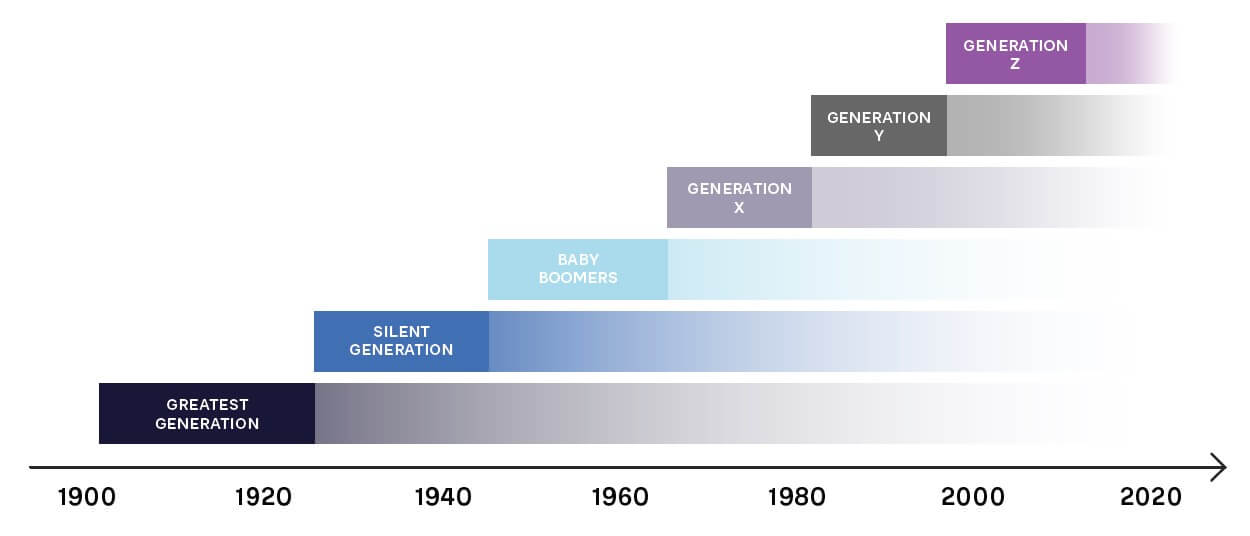
What sets Gen Z apart?
While acknowledging the risks associated with generalizations, we note several key traits and characteristics commonly observed among Gen Z individuals:
-
Tech prowess: Proficient in the use of technology, they perceive it as an inherent aspect of their surroundings, rather than a skill to be acquired.
-
Global perspective: The omnipresence of social media has significantly shaped Gen Z’s worldview. Exposure to a constant influx of information around the clock via platforms such as Instagram and X (formerly Twitter) has not only made them globally aware, but also influenced their perceptions of life, environmental issues, ethics, and standards of work and work-life balance. Social media serves as a powerful lens through which they interpret and engage with the world.
-
Challenging socioeconomic experiences: Many Gen Z individuals have witnessed the repercussions of the 2008 recession on their families, faced disruptions in education and early career steps because of the COVID-19 pandemic, and are currently contending with soaring housing costs. These issues are adversely affecting their mental health, with 42% diagnosed with specific conditions. For some Gen Zers, this has led to loss of trust in established political and institutional structures.
-
Diversity: Gen Z exemplifies a rich tapestry of backgrounds, with nearly half of its members in the US representing racial or ethnic minorities, as indicated by census data. This demographic intricacy is a testament to the profound impact of globalization, which has shaped Gen Z as products of increasingly heterogeneous societies or melting pots. Additionally, their heightened inclination toward pursuing higher education distinguishes them from preceding generations.
These factors all contribute to the formation of values that Gen Z holds dear. Their advocacy for inclusivity, diversity, and social responsibility stems from their unique experiences, coupled with a profound need for purpose in both personal and professional spheres. The omnipresence of social media leads to amplification of their opinions on a wide array of subjects, as well as greater active engagement. Consequently, this can create an impression of heightened knowledge and maturity, even among the youngest members of this cohort.
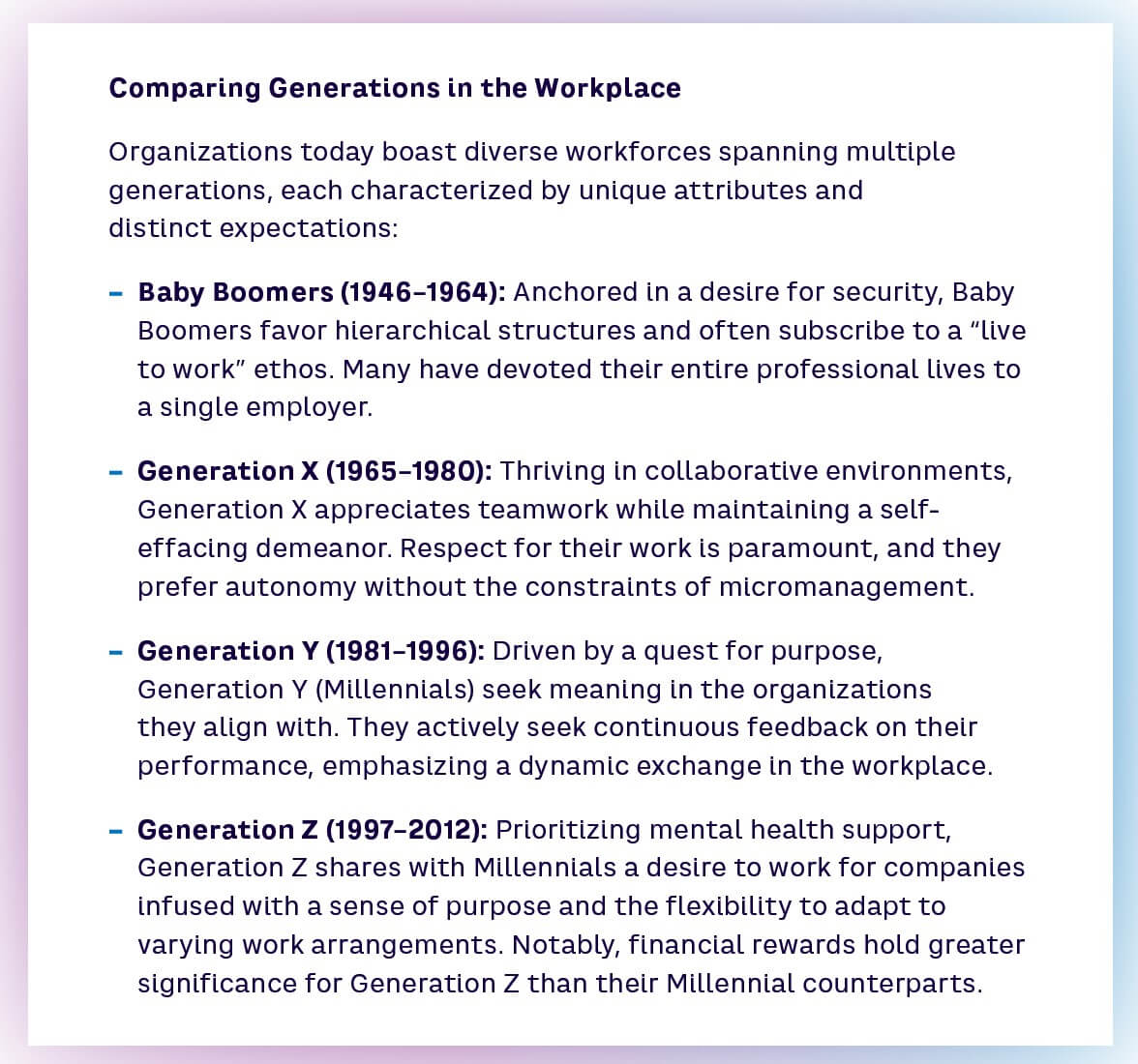
Perspectives from the Workplace
The oldest members of Gen Z have already entered the workforce, accumulating four to five years of experience and providing valuable insights into their impact on business. Simultaneously, the demand for their digital native skills has exponentially increased, underscoring the importance of comprehending and meeting their unique requirements. While differences persist between individuals, Gen Z characteristics can be generally distilled into four main areas:
1. High knowledge coupled with a high demand for purpose
Thanks to the internet, a majority of Gen Zers (52% in our research) possess preconceived notions about the world of work, forming strong opinions about specific companies and industries based on observed actions — mostly through the internet. They exhibit higher expectations than previous generations and, akin to Gen Y, seek employment with organizations that align with their values and purpose. Notably, financial motivation ranks higher for Gen Z, with 30% prioritizing fair wages.
2. Dislike of conflict and a preference to avoid confrontation
Raised in the online realm, Gen Zers may question existing norms and prove less adept in face-to-face situations. For instance, they may challenge set working hours, preferring flexibility to complete tasks efficiently. However, this lack of adherence to traditional norms may be perceived as unprofessional by older generations. Additionally, their digital upbringing may result in a lack of teamwork experience, which would make them more comfortable working independently. Conflict avoidance is a notable trait, and if they feel undervalued or unheard, Gen Z individuals are inclined to leave rather than engage in disputes, which underscores the pivotal role of managers in their retention.
3. Focus on work/life balance and job flexibility
Gen Z places a premium on achieving a satisfactory work/life balance, with 57% of those in our survey considering it central to a successful career. Motivated by the desire to safeguard their mental and physical wellbeing, they seek employer support, including access to wellbeing services, as standard. Notably, they exhibit a propensity to switch jobs regularly, especially if they feel unchallenged or underdeveloped. Retaining them beyond the initial learning and productivity phase is critical for organizations to realize the return on investment from their recruitment.
4. Dynamic work ethic with cross-functional engagement
Although Gen Z may challenge the need for set working hours, their work ethic remains strong when they are engaged properly, which leads them to exceed expectations — contrary to what some might believe.
“In fact, Gen Z’s level of engagement is high when they feel connected to a task. Sometimes, when they are too excited, they tend to go overboard, and actually even put in 150% of their personal attention and effort. Yet, when they are not excited, it’s difficult to engage them.” Hareth Alsahan, CHRO, Tawal
Given their wider interests and multidimensional digital skillsets, Gen Z often does not feel confined by the boundaries of a specific function, instead expecting to work across departments and areas. This creates challenges for traditional organizational structures put in place to deliver clear responsibilities and accountability.
Figure 2 shows that Gen Z has strong requirements across several areas. When asked to choose the three most important aspects of a successful career, nearly two-thirds of participants listed earning a high salary as one of the factors. They also aspire to achieve work/life balance while seeking managerial roles and constantly developing new skills.
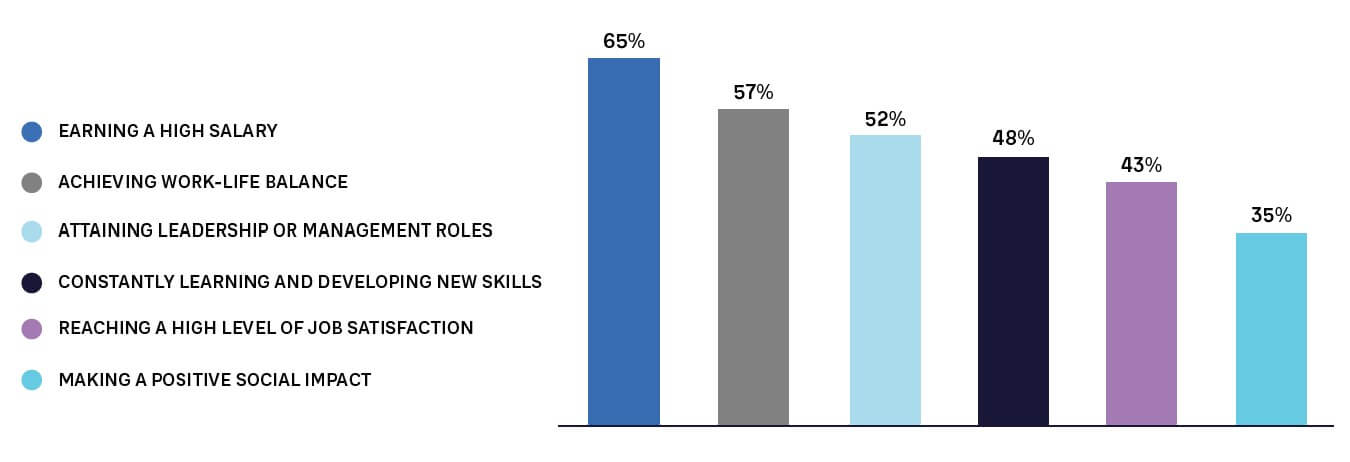
Unlocking Gen Z’s impact
Businesses are grappling with global scarcity of digital skills — even more so today with the advent of AI. This lack of digital tech talent poses an existential threat to business growth and innovation, with nearly 60% of employers reporting that not having enough skilled employees has a major or moderate impact on their operations. HR expert and co-author of this article Jérémy Lamri terms this challenge the “Talent Bomb,” which signals the looming threat of a skills gap jeopardizing organizational success. Gen Z emerges as a crucial force in defusing this bomb, offering essential digitalization and innovation skills. Notably, 74% of Gen Z individuals in our survey express positivity toward technology and AI, with none strongly opposing their rapid adoption.
Gen Z contributes speed and creativity to organizations, complementing existing strengths in process and performance. Their key skills and attitudes span:
-
Technology proficiency: As digital natives, Gen Z is positioned to assist companies in navigating dynamic technology and AI-driven markets.
-
Commitment to learning: Gen Zers, raised with easy access to online courses, YouTube, blogs, Wikipedia, and now generative AI, actively develop their skills, propelling organizational advancement through continuous learning.
-
Entrepreneurial mindset: Embracing failure and avoiding blind loyalty to methods, Gen Z exhibits openness to cultural change and a boundaryless approach to functions and teams.
-
Inclusive thinking: Advocating for empowerment and meritocracy, Gen Z prioritizes skills over gender or color, challenging traditional hierarchies.
-
Focus on purpose: Aligning with broader trends, Gen Z seeks organizations that have a clear sense of purpose, integrating values such as sustainability and ethical practices alongside financial performance.
Tailoring the Workplace for Gen Z: Strategic Recommendations for Employers
Building a Gen Z-compatible organization, while meeting the needs of other generations and creating ambidextrous structures, requires in-depth change management, focusing on five areas:
1. Establishing a Valid Sense of Purpose
Gen Zers are looking to work for organizations that share their sense of purpose, and already have strong opinions about many companies and industries based on their expansive networks and extensive internet exposure. Companies therefore need to transform and embrace this sense of purpose in everything they do, aligning it with their values to change their organizational DNA and working culture.
When asked to describe their ideal work culture, Gen Z responses included:
-
“An environment in which I am able to continue to learn and develop my skills, while also being able to maintain a healthy lifestyle outside of work.”
-
“A place where everyone is supportive, and I wake up excited to go to work.”
-
“Hybrid, challenging, aligned to my job aspirations, no corporate politics.”
Based on the earlier work of psychologist Kurt Lewin, transformations generally fit into one of two models:
-
Type I transformation: Adopting certain values (such as sustainability), but not embedding them within the organization’s economic model. Companies adopting this transformation assume their responsibilities (such as to the environment) without radically modifying their activities to align with that responsibility. In other words, the dominant nature of economic performance is not questioned, but rather, reconfigured to integrate ecological challenges. The primary business motive remains profit, but with the aim of “doing less harm.”
-
Type II transformation: Undergoing deep structural changes when adopting a value (such as sustainability) and integrating it at every level of the organization’s operations. This type of transformation requires emotional intelligence, open-mindedness, and a holistic vision. Type II transformation is a mutation, a profound change that requires courageous questioning of the status quo, intense awareness, and a strategic vision.
While Type I transformations may be a first step toward adopting important ecological values, they won’t meet the expectations of Gen Zers who look for an employer that “walks the talk.” Gen Zers may view it as window dressing, which can be counterproductive to attraction and retention efforts.
2. Changing Management and Leadership Behaviors
Managers, particularly from older generations, must adapt behaviors to accommodate Gen Z’s aversion to criticism, strong opinions, and desire for independence. This requires patience and open-mindedness to new perspectives from managers. Transformative leadership styles, emphasizing empathy and encouraging creativity, resonate well with Gen Z. For example, rather than a simple presentation at their annual performance review, a Gen Z employee may go further and propose creating a video displaying their achievements. Managers need to give Gen Z the space to experiment in these ways.
Gen Zers highlighted some of the challenges they face within the workplace, citing, for example:
-
“Not being taken seriously, with a negative outlook on our capabilities, being underestimated.”
-
“Unspoken rules that are outdated.”
-
“Gaining trust/respect from older employees is not easy, especially in leadership positions.”
3. Creating a Tailored Employee Journey
The sense of purpose and concern for Gen Z values has to extend across the employee journey from initial talent attraction and the hiring process, to developing their skills, all the way to their departure and staying in touch. Essentially, the double helix of organizational DNA (purpose and identity) has to be present at every step of the employee journey (see Figure 3).
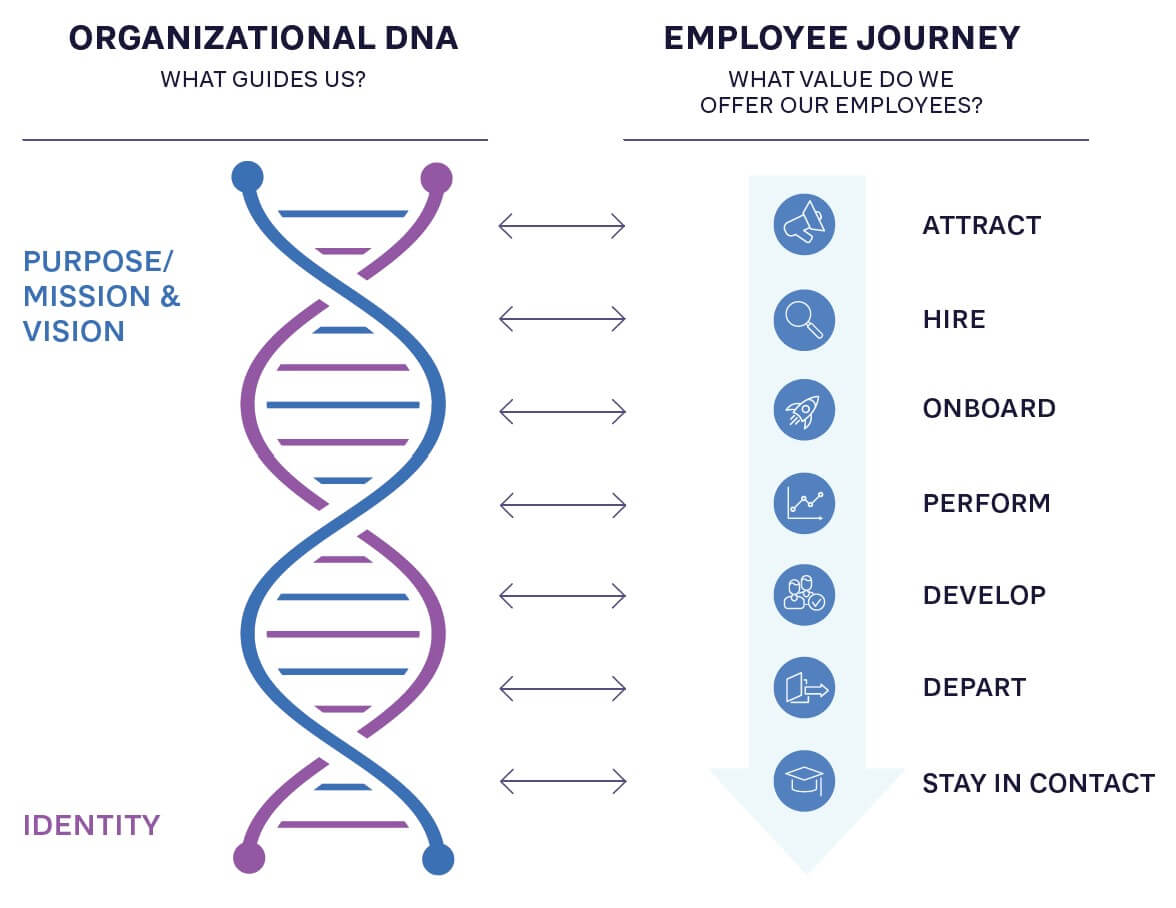
Purpose and identity must permeate every step of the employee journey, which necessitates an organization-wide commitment. Employee journey thinking benefits the organization by creating specific personas and tailored touchpoints for each cohort, which can be used to deliver value, as well as attract and retain Gen Z employees.
4. Transforming Structures and Ways of Working
Flexible, creative organizations require agile ways of working that replace bureaucracy and hierarchy with a lateral, competence-based approach. Gen Z employees thrive in this environment and culture, which brings creativity to existing structures and creates ambidextrous organizations. This transformation benefits overall business performance, creating a holacracy[1] that focuses on skills, capabilities, and ideas, rather than seniority.
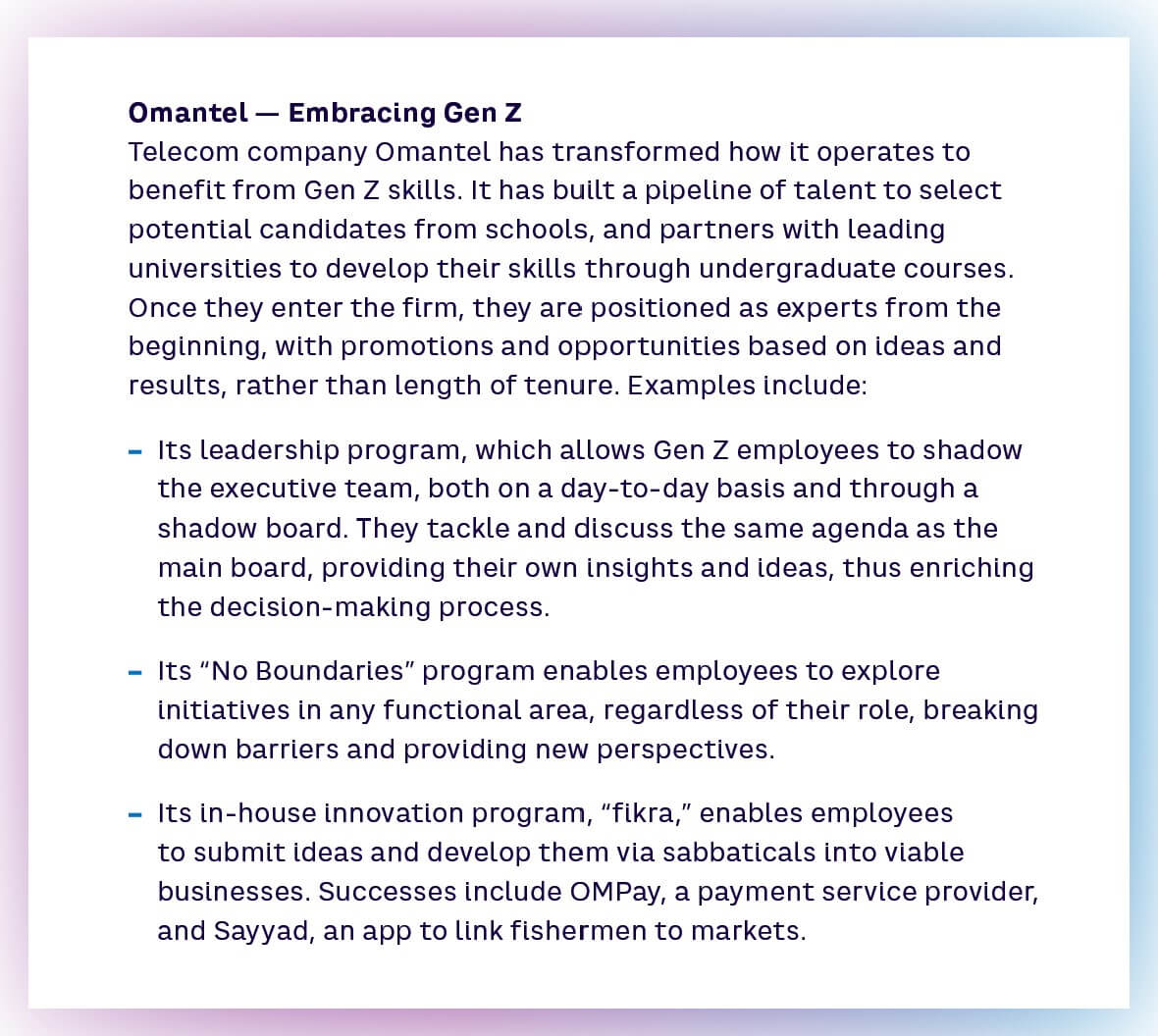
“It is very hard to retain Gen Z and its skills, requiring transformation in how we operate. The days of top-down decision making are long gone, meaning we’ve put in place the programs to get the best from Gen Z to transform the organization.” Chief People Officer, telecoms provider
5. Empowering Employees with Support and Tools
Gen Z employees are eager to develop and fast learners. Over three-quarters (78%) say a company’s commitment to providing ongoing career development opportunities influences their job choices. Therefore, providing them with the opportunities to grow is essential for their retention. This could be done within their current role, or, given their desire for change, through other roles within the organization, such as via rotation programs.
As digital natives, Gen Zers expect to have access to relevant technology within their roles. Empowering them with the right technology and tools (such as AI) will enable them to use their digital knowledge to lead and drive wider digital transformation within the organization. Not only will this benefit the business overall, but it will also enable employees to act as ambassadors for technology adoption, working with older generations to explain its benefits and motivate others to adopt it.
By 2035, Gen Z will be the largest generation in the workforce, taking up more management roles, reshaping the workplace, and refocusing organizations. Successful companies will focus on life-long learning, openness, and transformative leadership. This will enable them to meet the changing needs of markets that are also increasingly dominated by Gen Z consumers. Recognizing and aligning with the motivations and preferences of Gen Z is crucial for shaping HR strategies, underlining the significance of a nuanced approach that avoids broad generalizations and respects the distinct individuality of each employee. Furthermore, establishing an agile and lateral organizational structure that allows Gen Z to thrive within a diverse, multigenerational workforce is pivotal for positioning organizations favorably in the ever-evolving future.
Insights for the Executive
As organizations set sail into the Gen Z-driven future, HR professionals and CEOs must chart a strategic course to attract and retain this unique talent pool. Here are some first steps to integrate Gen Z into the workforce:
-
Cultivate open dialogue, collaboration, and understanding: Establish channels for transparent communication between leadership and Gen Z employees, while encouraging cross-generation dialogue to actively address challenges and opportunities.
-
Reassess current employee journey approaches: Examine current practices in recruitment, engagement, and retention to align with the unique needs of Gen Z. Consider adjustments in areas such as compensation, evaluation metrics, and working hours to attract and retain Gen Z talent. In doing this, companies should adopt a personalized approach, meeting individuals on their terms, and offer a diverse “portfolio of rewards” that allows employees to select options aligned with their preferences and motivations, rather than adopting a one-size-fits-all strategy.
-
Implement initiatives with Gen Z needs in mind: Co-develop strategic company initiatives around diversity, equity, and inclusion (DEI), as well as professional development, alongside Gen Z employees, ensuring alignment with their needs.
-
Establish continuous feedback and adaptation mechanisms: Implement robust systems for receiving feedback from Gen Z employees and the broader workforce regarding the effectiveness of initiatives, and adapt strategies accordingly.
Note
[1] Holacracy is a system of self-management in which leadership roles are not subject to a traditional hierarchy of command.

The future workforce
Recruiting and retaining vital Generation Z talent

DATE

Generation Z (widely known as Gen Z), encompassing those born between 1997 and 2012, is anticipated to make up over one-quarter of the global workforce by 2025, according to the World Economic Forum. As the first digitally native and globally connected generation, Gen Z brings distinctive skills and capabilities to organizations, making their recruitment and retention essential for sustained business success in the era of digital transformation and artificial intelligence (AI). This is especially significant for companies within traditional industrial sectors grappling with the challenges of digitization, striving to achieve ambidexterity by balancing agility and innovation with existing strengths in scale and productivity.
Nevertheless, the growing presence of Gen Z in the workforce comes with its own set of challenges. Gen Z as a whole possesses unique needs, expectations, and motivations, diverging from their immediate predecessors in Generation Y, commonly known as Millennials. Surprisingly, our research shows that only 26% of Gen Z individuals feel that current jobs align with their values. Effecting a transition toward Gen Z compatibility within organizations, without estranging current employees, demands transformative change and reconfiguration of management styles and structures.
Based on surveys of Gen Zers in North America, Europe, Southeast Asia, and the Middle East, as well as interviews with Global HR directors, this article outlines the essential measures organizations must undertake in terms of mission, structure, and culture to effectively harness the invaluable skills of their newest recruits.
Understanding Generation Z
Gen Z stands out as the first generation to grow up entirely in the digital era, devoid of any recollection of a world before the internet (see Figure 1). Unlike their Millennial counterparts, who embraced the internet later, in their developmental years, Gen Z members are genuine digital natives, having been immersed in technology since birth.

What sets Gen Z apart?
While acknowledging the risks associated with generalizations, we note several key traits and characteristics commonly observed among Gen Z individuals:
-
Tech prowess: Proficient in the use of technology, they perceive it as an inherent aspect of their surroundings, rather than a skill to be acquired.
-
Global perspective: The omnipresence of social media has significantly shaped Gen Z’s worldview. Exposure to a constant influx of information around the clock via platforms such as Instagram and X (formerly Twitter) has not only made them globally aware, but also influenced their perceptions of life, environmental issues, ethics, and standards of work and work-life balance. Social media serves as a powerful lens through which they interpret and engage with the world.
-
Challenging socioeconomic experiences: Many Gen Z individuals have witnessed the repercussions of the 2008 recession on their families, faced disruptions in education and early career steps because of the COVID-19 pandemic, and are currently contending with soaring housing costs. These issues are adversely affecting their mental health, with 42% diagnosed with specific conditions. For some Gen Zers, this has led to loss of trust in established political and institutional structures.
-
Diversity: Gen Z exemplifies a rich tapestry of backgrounds, with nearly half of its members in the US representing racial or ethnic minorities, as indicated by census data. This demographic intricacy is a testament to the profound impact of globalization, which has shaped Gen Z as products of increasingly heterogeneous societies or melting pots. Additionally, their heightened inclination toward pursuing higher education distinguishes them from preceding generations.
These factors all contribute to the formation of values that Gen Z holds dear. Their advocacy for inclusivity, diversity, and social responsibility stems from their unique experiences, coupled with a profound need for purpose in both personal and professional spheres. The omnipresence of social media leads to amplification of their opinions on a wide array of subjects, as well as greater active engagement. Consequently, this can create an impression of heightened knowledge and maturity, even among the youngest members of this cohort.

Perspectives from the Workplace
The oldest members of Gen Z have already entered the workforce, accumulating four to five years of experience and providing valuable insights into their impact on business. Simultaneously, the demand for their digital native skills has exponentially increased, underscoring the importance of comprehending and meeting their unique requirements. While differences persist between individuals, Gen Z characteristics can be generally distilled into four main areas:
1. High knowledge coupled with a high demand for purpose
Thanks to the internet, a majority of Gen Zers (52% in our research) possess preconceived notions about the world of work, forming strong opinions about specific companies and industries based on observed actions — mostly through the internet. They exhibit higher expectations than previous generations and, akin to Gen Y, seek employment with organizations that align with their values and purpose. Notably, financial motivation ranks higher for Gen Z, with 30% prioritizing fair wages.
2. Dislike of conflict and a preference to avoid confrontation
Raised in the online realm, Gen Zers may question existing norms and prove less adept in face-to-face situations. For instance, they may challenge set working hours, preferring flexibility to complete tasks efficiently. However, this lack of adherence to traditional norms may be perceived as unprofessional by older generations. Additionally, their digital upbringing may result in a lack of teamwork experience, which would make them more comfortable working independently. Conflict avoidance is a notable trait, and if they feel undervalued or unheard, Gen Z individuals are inclined to leave rather than engage in disputes, which underscores the pivotal role of managers in their retention.
3. Focus on work/life balance and job flexibility
Gen Z places a premium on achieving a satisfactory work/life balance, with 57% of those in our survey considering it central to a successful career. Motivated by the desire to safeguard their mental and physical wellbeing, they seek employer support, including access to wellbeing services, as standard. Notably, they exhibit a propensity to switch jobs regularly, especially if they feel unchallenged or underdeveloped. Retaining them beyond the initial learning and productivity phase is critical for organizations to realize the return on investment from their recruitment.
4. Dynamic work ethic with cross-functional engagement
Although Gen Z may challenge the need for set working hours, their work ethic remains strong when they are engaged properly, which leads them to exceed expectations — contrary to what some might believe.
“In fact, Gen Z’s level of engagement is high when they feel connected to a task. Sometimes, when they are too excited, they tend to go overboard, and actually even put in 150% of their personal attention and effort. Yet, when they are not excited, it’s difficult to engage them.” Hareth Alsahan, CHRO, Tawal
Given their wider interests and multidimensional digital skillsets, Gen Z often does not feel confined by the boundaries of a specific function, instead expecting to work across departments and areas. This creates challenges for traditional organizational structures put in place to deliver clear responsibilities and accountability.
Figure 2 shows that Gen Z has strong requirements across several areas. When asked to choose the three most important aspects of a successful career, nearly two-thirds of participants listed earning a high salary as one of the factors. They also aspire to achieve work/life balance while seeking managerial roles and constantly developing new skills.

Unlocking Gen Z’s impact
Businesses are grappling with global scarcity of digital skills — even more so today with the advent of AI. This lack of digital tech talent poses an existential threat to business growth and innovation, with nearly 60% of employers reporting that not having enough skilled employees has a major or moderate impact on their operations. HR expert and co-author of this article Jérémy Lamri terms this challenge the “Talent Bomb,” which signals the looming threat of a skills gap jeopardizing organizational success. Gen Z emerges as a crucial force in defusing this bomb, offering essential digitalization and innovation skills. Notably, 74% of Gen Z individuals in our survey express positivity toward technology and AI, with none strongly opposing their rapid adoption.
Gen Z contributes speed and creativity to organizations, complementing existing strengths in process and performance. Their key skills and attitudes span:
-
Technology proficiency: As digital natives, Gen Z is positioned to assist companies in navigating dynamic technology and AI-driven markets.
-
Commitment to learning: Gen Zers, raised with easy access to online courses, YouTube, blogs, Wikipedia, and now generative AI, actively develop their skills, propelling organizational advancement through continuous learning.
-
Entrepreneurial mindset: Embracing failure and avoiding blind loyalty to methods, Gen Z exhibits openness to cultural change and a boundaryless approach to functions and teams.
-
Inclusive thinking: Advocating for empowerment and meritocracy, Gen Z prioritizes skills over gender or color, challenging traditional hierarchies.
-
Focus on purpose: Aligning with broader trends, Gen Z seeks organizations that have a clear sense of purpose, integrating values such as sustainability and ethical practices alongside financial performance.
Tailoring the Workplace for Gen Z: Strategic Recommendations for Employers
Building a Gen Z-compatible organization, while meeting the needs of other generations and creating ambidextrous structures, requires in-depth change management, focusing on five areas:
1. Establishing a Valid Sense of Purpose
Gen Zers are looking to work for organizations that share their sense of purpose, and already have strong opinions about many companies and industries based on their expansive networks and extensive internet exposure. Companies therefore need to transform and embrace this sense of purpose in everything they do, aligning it with their values to change their organizational DNA and working culture.
When asked to describe their ideal work culture, Gen Z responses included:
-
“An environment in which I am able to continue to learn and develop my skills, while also being able to maintain a healthy lifestyle outside of work.”
-
“A place where everyone is supportive, and I wake up excited to go to work.”
-
“Hybrid, challenging, aligned to my job aspirations, no corporate politics.”
Based on the earlier work of psychologist Kurt Lewin, transformations generally fit into one of two models:
-
Type I transformation: Adopting certain values (such as sustainability), but not embedding them within the organization’s economic model. Companies adopting this transformation assume their responsibilities (such as to the environment) without radically modifying their activities to align with that responsibility. In other words, the dominant nature of economic performance is not questioned, but rather, reconfigured to integrate ecological challenges. The primary business motive remains profit, but with the aim of “doing less harm.”
-
Type II transformation: Undergoing deep structural changes when adopting a value (such as sustainability) and integrating it at every level of the organization’s operations. This type of transformation requires emotional intelligence, open-mindedness, and a holistic vision. Type II transformation is a mutation, a profound change that requires courageous questioning of the status quo, intense awareness, and a strategic vision.
While Type I transformations may be a first step toward adopting important ecological values, they won’t meet the expectations of Gen Zers who look for an employer that “walks the talk.” Gen Zers may view it as window dressing, which can be counterproductive to attraction and retention efforts.
2. Changing Management and Leadership Behaviors
Managers, particularly from older generations, must adapt behaviors to accommodate Gen Z’s aversion to criticism, strong opinions, and desire for independence. This requires patience and open-mindedness to new perspectives from managers. Transformative leadership styles, emphasizing empathy and encouraging creativity, resonate well with Gen Z. For example, rather than a simple presentation at their annual performance review, a Gen Z employee may go further and propose creating a video displaying their achievements. Managers need to give Gen Z the space to experiment in these ways.
Gen Zers highlighted some of the challenges they face within the workplace, citing, for example:
-
“Not being taken seriously, with a negative outlook on our capabilities, being underestimated.”
-
“Unspoken rules that are outdated.”
-
“Gaining trust/respect from older employees is not easy, especially in leadership positions.”
3. Creating a Tailored Employee Journey
The sense of purpose and concern for Gen Z values has to extend across the employee journey from initial talent attraction and the hiring process, to developing their skills, all the way to their departure and staying in touch. Essentially, the double helix of organizational DNA (purpose and identity) has to be present at every step of the employee journey (see Figure 3).

Purpose and identity must permeate every step of the employee journey, which necessitates an organization-wide commitment. Employee journey thinking benefits the organization by creating specific personas and tailored touchpoints for each cohort, which can be used to deliver value, as well as attract and retain Gen Z employees.
4. Transforming Structures and Ways of Working
Flexible, creative organizations require agile ways of working that replace bureaucracy and hierarchy with a lateral, competence-based approach. Gen Z employees thrive in this environment and culture, which brings creativity to existing structures and creates ambidextrous organizations. This transformation benefits overall business performance, creating a holacracy[1] that focuses on skills, capabilities, and ideas, rather than seniority.

“It is very hard to retain Gen Z and its skills, requiring transformation in how we operate. The days of top-down decision making are long gone, meaning we’ve put in place the programs to get the best from Gen Z to transform the organization.” Chief People Officer, telecoms provider
5. Empowering Employees with Support and Tools
Gen Z employees are eager to develop and fast learners. Over three-quarters (78%) say a company’s commitment to providing ongoing career development opportunities influences their job choices. Therefore, providing them with the opportunities to grow is essential for their retention. This could be done within their current role, or, given their desire for change, through other roles within the organization, such as via rotation programs.
As digital natives, Gen Zers expect to have access to relevant technology within their roles. Empowering them with the right technology and tools (such as AI) will enable them to use their digital knowledge to lead and drive wider digital transformation within the organization. Not only will this benefit the business overall, but it will also enable employees to act as ambassadors for technology adoption, working with older generations to explain its benefits and motivate others to adopt it.
By 2035, Gen Z will be the largest generation in the workforce, taking up more management roles, reshaping the workplace, and refocusing organizations. Successful companies will focus on life-long learning, openness, and transformative leadership. This will enable them to meet the changing needs of markets that are also increasingly dominated by Gen Z consumers. Recognizing and aligning with the motivations and preferences of Gen Z is crucial for shaping HR strategies, underlining the significance of a nuanced approach that avoids broad generalizations and respects the distinct individuality of each employee. Furthermore, establishing an agile and lateral organizational structure that allows Gen Z to thrive within a diverse, multigenerational workforce is pivotal for positioning organizations favorably in the ever-evolving future.
Insights for the Executive
As organizations set sail into the Gen Z-driven future, HR professionals and CEOs must chart a strategic course to attract and retain this unique talent pool. Here are some first steps to integrate Gen Z into the workforce:
-
Cultivate open dialogue, collaboration, and understanding: Establish channels for transparent communication between leadership and Gen Z employees, while encouraging cross-generation dialogue to actively address challenges and opportunities.
-
Reassess current employee journey approaches: Examine current practices in recruitment, engagement, and retention to align with the unique needs of Gen Z. Consider adjustments in areas such as compensation, evaluation metrics, and working hours to attract and retain Gen Z talent. In doing this, companies should adopt a personalized approach, meeting individuals on their terms, and offer a diverse “portfolio of rewards” that allows employees to select options aligned with their preferences and motivations, rather than adopting a one-size-fits-all strategy.
-
Implement initiatives with Gen Z needs in mind: Co-develop strategic company initiatives around diversity, equity, and inclusion (DEI), as well as professional development, alongside Gen Z employees, ensuring alignment with their needs.
-
Establish continuous feedback and adaptation mechanisms: Implement robust systems for receiving feedback from Gen Z employees and the broader workforce regarding the effectiveness of initiatives, and adapt strategies accordingly.
Note
[1] Holacracy is a system of self-management in which leadership roles are not subject to a traditional hierarchy of command.
